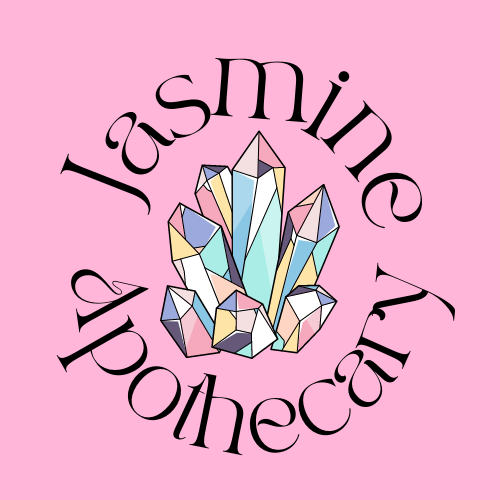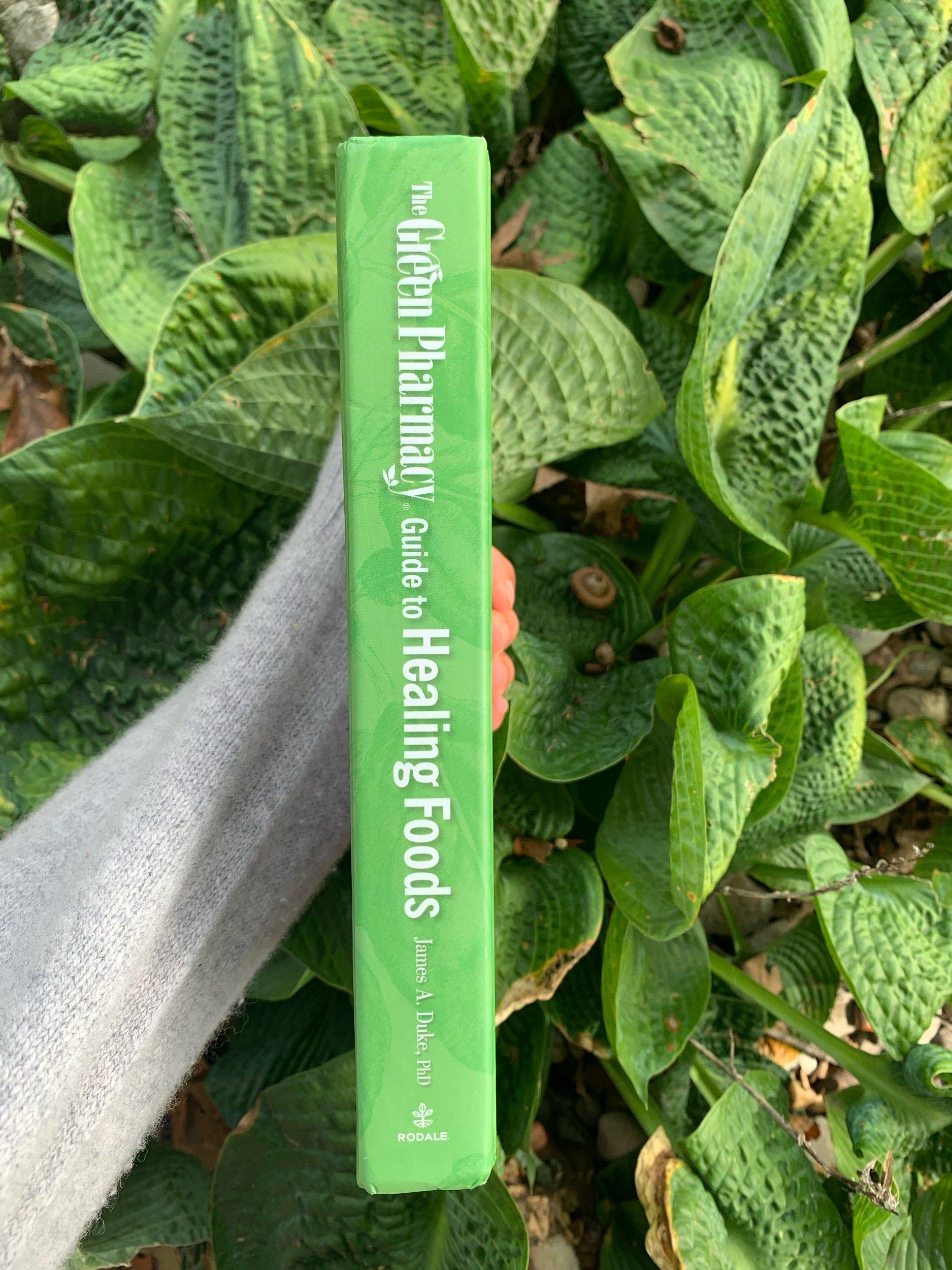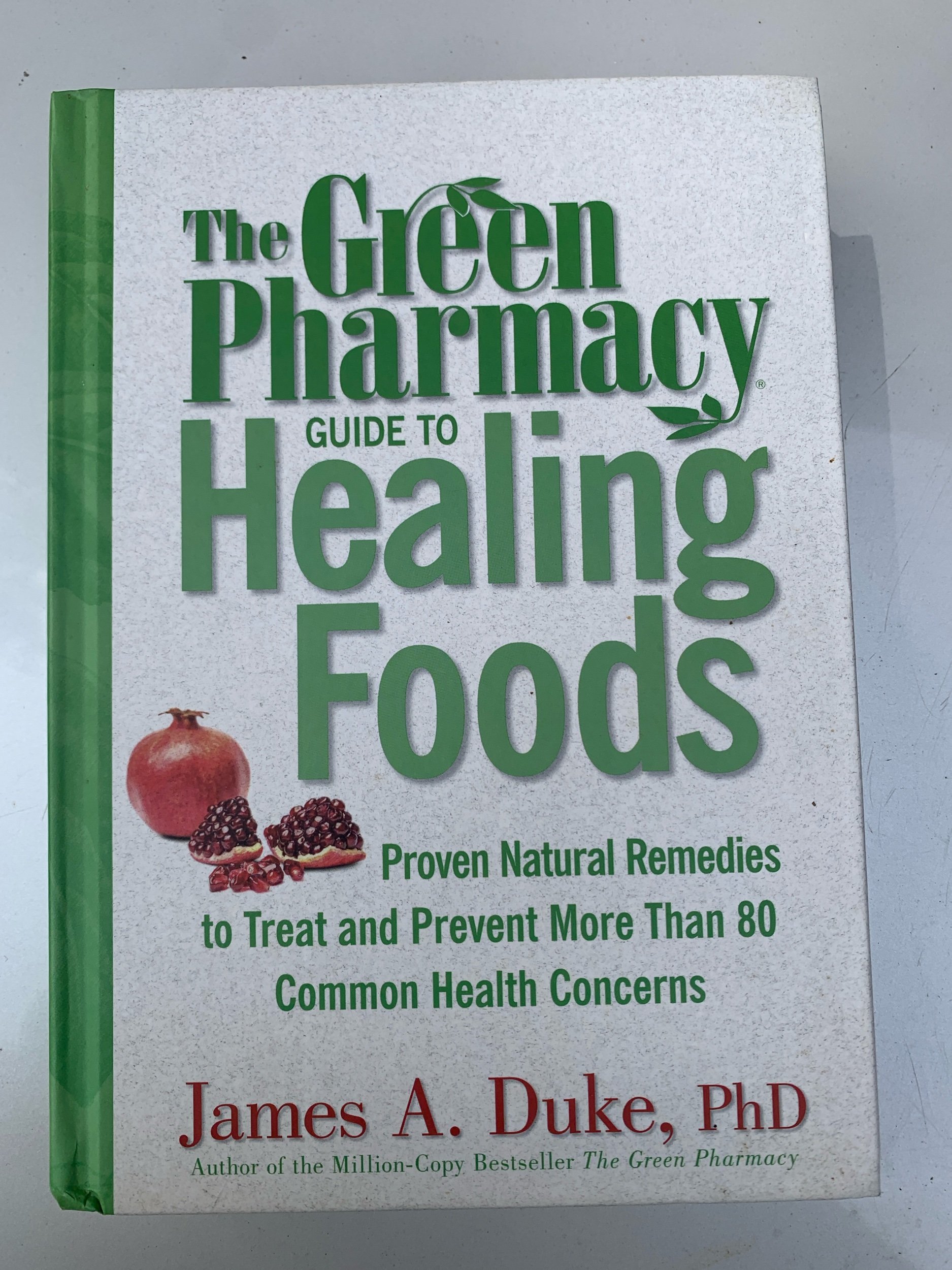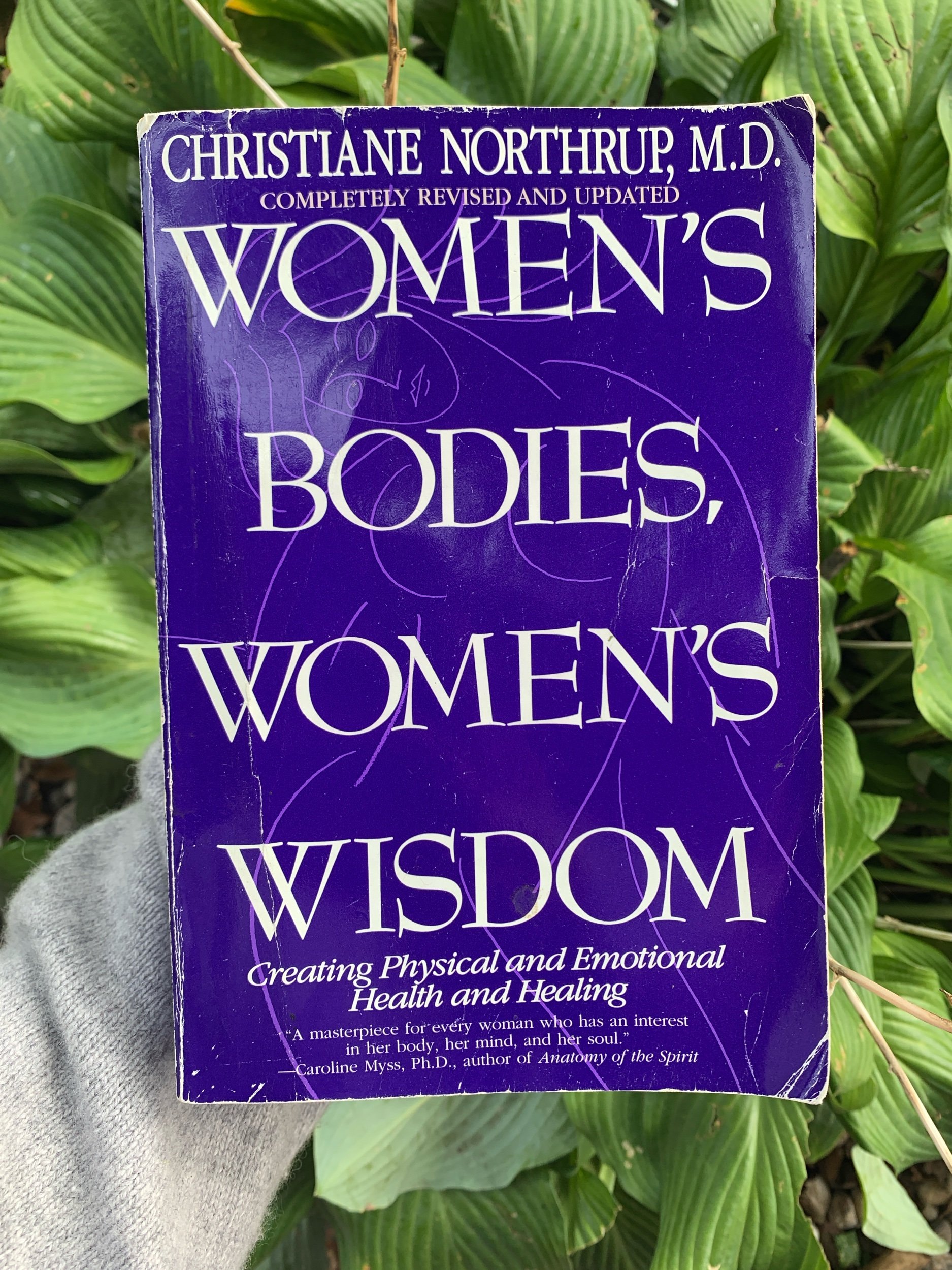The Green Pharmacy Guide to Healing Foods: Proven Natural Remedies to Treat and Prevent More Than 80 Common Health Concerns By: James A. Duke
Upon its publication more than a decade ago, Dr. James Duke's The Green Pharmacy quickly set the standard for consumer herb references. A favorite of laypeople and professionals alike, the book sold more than a million copies and solidified the author's reputation as one of the world's foremost authorities on medicinal plants.
In The Green Pharmacy Guide to Healing Foods, Dr. Duke turns to the broader and even more popular subject of food as medicine, drawing on more than thirty years of research to identify the most powerful healing foods on earth. Whether he is revealing how to beat high cholesterol with blueberries, combat hot flashes with black beans, bash blood sugar spikes with almonds, or help relieve agonizing back pain with pineapple, Dr. Duke's food remedies help treat and prevent the whole gamut of health concerns, from minor (such as sunburn and the common cold) to more serious (like arthritis and diabetes).
Dr. Duke has assigned a rating to each remedy, according to his evaluation of the available scientific studies and anecdotal reports. Many of the healing foods recommended here are proving so effective that they may outperform popular pharmaceuticals—minus the risk (and cost).
About the Author
JAMES A. DUKE, PHD, held several posts in his more than three decades with the US Department of Agriculture, including chief of the Medicinal Plant Resources Laboratory. He is the author of numerous scholarly and popular books, including the bestseller The Green Pharmacy, and is on the board of advisors for Prevention. He resides in Fulton, Maryland.
Excerpt. © Reprinted by permission. All rights reserved.
CHAPTER 1
How Foods Heal
"Medicinal Foods" through the Ages--From Ancient to Modern Times
If you're familiar with my Green Pharmacy (or Farmacy, as I like to call it), you probably think that it's all about herbal remedies. That's partially true. Herbs have always been near and dear to my heart, and they still are. However, research over the past few decades has taken the Green Pharmacy in a new and interesting direction--away from the health food store and into the supermarket.
A growing body of literature indicates that a number of plant foods-- fruits, vegetables, spices, and even beverages--offer many of the same healing powers that you'll find in herbal remedies. Foods, however, have a distinct advantage over their herbal cousins: Instead of depending on capsules, tinctures, and teas, you can incorporate foods into delicious, flavorful meals that are as satisfying as they are healing!
Of course, we all know that fruits and vegetables are healthful. That's why the government recently increased its recommendation from five servings to nine a day. But only now are we learning just how healthful they really are. To begin with, they're high in fiber, low in calories, and devoid of or low in harmful fats. But that's not all. Most have hundreds, if not thousands, of medicinal com£ds, each of which has a specific impact on your health and well-being. As a result, you can choose to add various plants to your diet to treat certain ailments. For example, I eat celery almost every day to prevent the pain associated with gout, and garlic is part of my diet because I know it can benefit my heart and possibly even help control my chronic Lyme disease.
Over the next few pages, I'll give you some background on how plant foods heal, so you can gain a greater understanding of their role in your health. Then, in the chapters to come, I'll help you plan your own regimen to treat specific conditions with specific foods.
Food as a Historical Healer
The idea of "food as medicine" is hardly a new one. In fact, when you consider that ancient man lacked the technological capability of today's chemists, it only makes sense that their medicines came directly from nature.
In fact, evidence of using food to heal dates back thousands of years. Ayurveda, the traditional healing art of India, is a perfect example. It borrows many of its ideas from Hinduism, incorporating multiple therapies that include herbs, massage, and meditation. Ayurvedic practitioners may even go so far as to try a new diet to prevent or treat specific conditions. One medicinal food from Ayurveda may be familiar to you: turmeric, which often shows up as a spice in Asian cuisine. Aside from its unique flavor, turmeric may also prove a helpful treatment for people with arthritis, Alzheimer's disease, and some forms of cancer. Although the research evidence isn't yet conclusive, it's certainly highly suggestive, and my own experience using turmeric as an anti-inflammatory has been extraordinarily positive. (For more information on turmeric, see page 28.)
Ayurveda, also commonly referred to as Traditional Indian Medicine or Traditional Ayurvedic Medicine (TAM), shares this focus on food with another ancient form of medical practice, Traditional Chinese Medicine (TCM). TCM works from the concepts of "yin" and "yang," which in ancient Chinese philosophy refer to the two fundamental forces in the universe--the aggressive, hot, go-get-'em force (yang); and the passive, lie back and chill out force (yin). You get sick when these two forces fall out of balance in your body.
By now you're probably wondering what all of this has to do with food. In TCM, the foods you eat are seen as having yin properties--cooling and moistening--or yang properties--warming and drying. Depending on the condition you have, your practitioner will help you make food choices to restore balance between the two forces. For example, if you have a mucus- producing cough from a cold, your balance is skewed toward the yin, so you'll want to treat it with warming, drying foods like ginger tea and hot vegetable soups. As you can see, we borrow some of our ideas for treating illness from the Chinese, whether we're aware of it or not!
Upon its publication more than a decade ago, Dr. James Duke's The Green Pharmacy quickly set the standard for consumer herb references. A favorite of laypeople and professionals alike, the book sold more than a million copies and solidified the author's reputation as one of the world's foremost authorities on medicinal plants.
In The Green Pharmacy Guide to Healing Foods, Dr. Duke turns to the broader and even more popular subject of food as medicine, drawing on more than thirty years of research to identify the most powerful healing foods on earth. Whether he is revealing how to beat high cholesterol with blueberries, combat hot flashes with black beans, bash blood sugar spikes with almonds, or help relieve agonizing back pain with pineapple, Dr. Duke's food remedies help treat and prevent the whole gamut of health concerns, from minor (such as sunburn and the common cold) to more serious (like arthritis and diabetes).
Dr. Duke has assigned a rating to each remedy, according to his evaluation of the available scientific studies and anecdotal reports. Many of the healing foods recommended here are proving so effective that they may outperform popular pharmaceuticals—minus the risk (and cost).
About the Author
JAMES A. DUKE, PHD, held several posts in his more than three decades with the US Department of Agriculture, including chief of the Medicinal Plant Resources Laboratory. He is the author of numerous scholarly and popular books, including the bestseller The Green Pharmacy, and is on the board of advisors for Prevention. He resides in Fulton, Maryland.
Excerpt. © Reprinted by permission. All rights reserved.
CHAPTER 1
How Foods Heal
"Medicinal Foods" through the Ages--From Ancient to Modern Times
If you're familiar with my Green Pharmacy (or Farmacy, as I like to call it), you probably think that it's all about herbal remedies. That's partially true. Herbs have always been near and dear to my heart, and they still are. However, research over the past few decades has taken the Green Pharmacy in a new and interesting direction--away from the health food store and into the supermarket.
A growing body of literature indicates that a number of plant foods-- fruits, vegetables, spices, and even beverages--offer many of the same healing powers that you'll find in herbal remedies. Foods, however, have a distinct advantage over their herbal cousins: Instead of depending on capsules, tinctures, and teas, you can incorporate foods into delicious, flavorful meals that are as satisfying as they are healing!
Of course, we all know that fruits and vegetables are healthful. That's why the government recently increased its recommendation from five servings to nine a day. But only now are we learning just how healthful they really are. To begin with, they're high in fiber, low in calories, and devoid of or low in harmful fats. But that's not all. Most have hundreds, if not thousands, of medicinal com£ds, each of which has a specific impact on your health and well-being. As a result, you can choose to add various plants to your diet to treat certain ailments. For example, I eat celery almost every day to prevent the pain associated with gout, and garlic is part of my diet because I know it can benefit my heart and possibly even help control my chronic Lyme disease.
Over the next few pages, I'll give you some background on how plant foods heal, so you can gain a greater understanding of their role in your health. Then, in the chapters to come, I'll help you plan your own regimen to treat specific conditions with specific foods.
Food as a Historical Healer
The idea of "food as medicine" is hardly a new one. In fact, when you consider that ancient man lacked the technological capability of today's chemists, it only makes sense that their medicines came directly from nature.
In fact, evidence of using food to heal dates back thousands of years. Ayurveda, the traditional healing art of India, is a perfect example. It borrows many of its ideas from Hinduism, incorporating multiple therapies that include herbs, massage, and meditation. Ayurvedic practitioners may even go so far as to try a new diet to prevent or treat specific conditions. One medicinal food from Ayurveda may be familiar to you: turmeric, which often shows up as a spice in Asian cuisine. Aside from its unique flavor, turmeric may also prove a helpful treatment for people with arthritis, Alzheimer's disease, and some forms of cancer. Although the research evidence isn't yet conclusive, it's certainly highly suggestive, and my own experience using turmeric as an anti-inflammatory has been extraordinarily positive. (For more information on turmeric, see page 28.)
Ayurveda, also commonly referred to as Traditional Indian Medicine or Traditional Ayurvedic Medicine (TAM), shares this focus on food with another ancient form of medical practice, Traditional Chinese Medicine (TCM). TCM works from the concepts of "yin" and "yang," which in ancient Chinese philosophy refer to the two fundamental forces in the universe--the aggressive, hot, go-get-'em force (yang); and the passive, lie back and chill out force (yin). You get sick when these two forces fall out of balance in your body.
By now you're probably wondering what all of this has to do with food. In TCM, the foods you eat are seen as having yin properties--cooling and moistening--or yang properties--warming and drying. Depending on the condition you have, your practitioner will help you make food choices to restore balance between the two forces. For example, if you have a mucus- producing cough from a cold, your balance is skewed toward the yin, so you'll want to treat it with warming, drying foods like ginger tea and hot vegetable soups. As you can see, we borrow some of our ideas for treating illness from the Chinese, whether we're aware of it or not!














